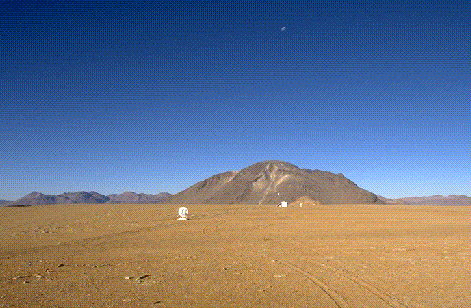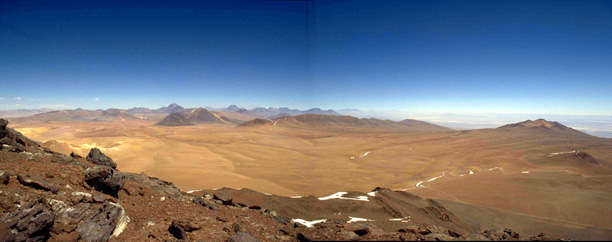
Moonrise over NRAO test equipment near Cerro Chajnantor, Chile.
Photo: S. Radford, 1995 May.
| National Radio Astronomy Observatory |

To evaluate possible sites for the Millimeter Array, NRAO has carried out site test campaigns at several locations. The most promising site is at 5000 m altitude near Cerro Chajnantor in northern Chile. This is about 40 km east of the historic village of San Pedro de Atacama, 130 km southeast of the mining town of Calama, and about 275 km ENE of the coastal port of Antofagasta.
On Chajnantor we have deployed a suite of autonomous instruments since 1995 April. These include a 225 GHz tipping radiometer that measures atmospheric transparency and temporal emission fluctuations, a 12 GHz interferometer that measures atmospheric phase fluctuations, and a surveillance camera. A submillimeter tipping photometer, which measures the atmospheric transparency at 350 micron wavelength, and a submillimeter Fourier transform spectrometer, developed by the Smithsonian Astrophysical Observatory Submillimeter Receiver Lab, were both deployed in 1997 October. A campaign of radiosonde launches will begin in 1998 October. Similar instruments have been deployed at other sites, notably Mauna Kea, Hawaii (4100 m), and the South Pole (2835 m), by NRAO and other groups.
These measurements indicate Chajnantor is an excellent site for millimeter and submillimeter wavelength astronomy. The 225 GHz transparency and phase stability are both better than on Mauna Kea. Moreover, the diurnal variation in both transparency and phase stability is less pronounced on Chajnantor than on Mauna Kea. Indeed, there is almost no diurnal variation in transparency on Chajnantor. The median 225 GHz transparencies measured at Chajnantor and at the South Pole are comparable.
